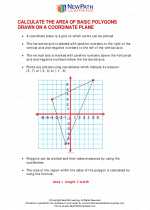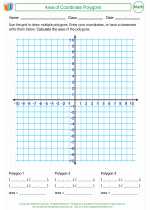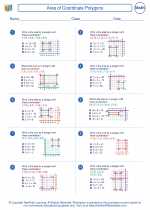Area of Coordinate Polygons -> polygon
Polygon
A polygon is a closed figure made up of straight line segments. Each line segment is called a side, and each endpoint where two sides meet is called a vertex. Polygons can be classified by the number of sides they have. The most common polygons are triangles (3 sides), quadrilaterals (4 sides), pentagons (5 sides), hexagons (6 sides), heptagons (7 sides), octagons (8 sides), nonagons (9 sides), and decagons (10 sides).
Types of Polygons:
- Triangle: A polygon with 3 sides and 3 vertices.
- Quadrilateral: A polygon with 4 sides and 4 vertices.
- Pentagon: A polygon with 5 sides and 5 vertices.
- Hexagon: A polygon with 6 sides and 6 vertices.
- Heptagon: A polygon with 7 sides and 7 vertices.
- Octagon: A polygon with 8 sides and 8 vertices.
- Nonagon: A polygon with 9 sides and 9 vertices.
- Decagon: A polygon with 10 sides and 10 vertices.
Properties of Polygons:
Some important properties of polygons include:
- Interior Angles: The sum of the interior angles of a polygon with n sides is given by the formula (n-2) * 180 degrees.
- Exterior Angles: The sum of the exterior angles of any polygon, whether convex or concave, is always 360 degrees.
- Regular and Irregular Polygons: A polygon is called regular if all its sides are of equal length and all its angles are of equal measure. If any of the sides or angles are different, then it is called an irregular polygon.
- Diagonals: A diagonal is a line segment that connects two non-adjacent vertices of a polygon. The number of diagonals in a polygon can be calculated using the formula n * (n-3) / 2, where n is the number of sides of the polygon.
Study Guide:
To study polygons, it's important to familiarize yourself with the properties and types of polygons. Practice identifying and classifying different polygons based on the number of sides and vertices. Additionally, practice calculating the interior and exterior angles of polygons using the relevant formulas. Work on differentiating between regular and irregular polygons and understanding the concept of diagonals in polygons.
It can also be helpful to work on exercises that involve finding the perimeter and area of different polygons, as well as applying the properties of polygons to solve real-life problems.
Remember to review the formulas and properties regularly to reinforce your understanding of polygons.
[Polygon] Related Worksheets and Study Guides:
.◂Math Worksheets and Study Guides Sixth Grade. Area of Coordinate Polygons

 Activity Lesson
Activity Lesson
 Worksheet/Answer key
Worksheet/Answer key
 Worksheet/Answer key
Worksheet/Answer key
 Worksheet/Answer key
Worksheet/Answer key
